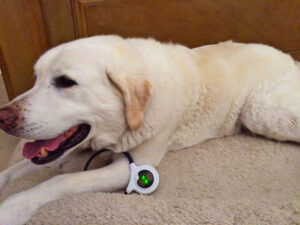Why Is My Dog Pacing?
Have you ever caught yourself pacing? Perhaps you were chatting on the phone or lost deep in thought and found yourself walking back and forth across your living room? Maybe you were waiting for someone to arrive, or thinking about a meeting you had to attend later that day? Sometimes we don’t even realize that we’re pacing – that’s because it’s often a subconscious activity we’re doing to cope with something, whether that be stress, excitement, or confusion. It’s the same with our dogs – except they’re not able to reflect on why they’re exhibiting this behavior. That’s where you come in. If you notice your dog pacing, your veterinarian or behavioral consultant – along with this guide – will help you investigate the cause and find a solution.
What’s the First Step for Managing Canine Pacing?
Our canine companions may have the ability to recognize when something is “off” about them or their environment, but the jury is still out on the degree to which dogs have self-awareness. While we can catch ourselves pacing and investigate the cause, dogs cannot analyze their behavior – they rely on us to help them!
So, to resolve whatever is causing your dog’s pacing, your first step is to record details about your dog’s behavior. While pacing is a common, natural behavior, excessive pacing might indicate that there is an underlying issue at play.
What Are the Most Common Causes of Pacing in Dogs?
As with humans, canine pacing is a physical manifestation of an underlying emotional state. A dog might begin pacing out of excitement, hunger, or perhaps due to environmental triggers, including noises and smells. Sometimes, dogs in heat and dogs searching for mates might even begin pacing or exhibit other restless behaviors.
In mild cases, a dog will walk in circles or back and forth without a specific purpose or destination in mind. However, they’ll manage to settle down in between brief episodes of pacing or stop after ten or fifteen minutes.
However, excessive, frequent pacing might indicate that there is something more serious going on. No matter what, it is important to closely observe your dog’s behavior and daily routine in order to get a better sense of what might be causing their pacing. In more severe cases, the dog will seem distressed or panicked. They’ll trot or even run between exit points almost constantly. Some of the most common causes of pacing include:
1. Anxiety
If your dog is anxious or stressed out, pacing may become an outlet for them – a way for them to express their emotions. But how can you tell if anxiety is causing your dog’s behavior? A veterinarian will help you investigate what seems to be triggering your dog’s pacing and what you can do to help. They may conclude that your pet’s pacing is the result of generalized anxiety or a specific form of anxiety such as separation anxiety.
It is important to investigate the underlying cause(s) of your dog’s anxiety or stress, as there may be something more serious going on, such as an underlying health issue. Cushing’s Disease, for example, affects cortisone, a stress hormone; this may result in anxious pacing. Liver abnormalities can also cause neurological symptoms, including pacing and head pressing.
2. Boredom
A lack of exercise, stimulation, and attention can cause a dog to pace. Looking for a way to exert energy or get your attention, a dog may pace around the house in order to burn off excess fuel.
3. Pain-related Issues

Pain – and the inflammation that accompanies it – is closely related to anxiety. Think back on a time when you were injured. How was your mood? Oftentimes, pain puts a toll on the mind, too, causing stress, anxiety, and even depression. With this in mind, it makes sense that, if your dog is in pain, they might exhibit anxious behaviors – including pacing. Pain can also make it difficult for a dog to transition from standing to sitting or lying down, which may cause a dog to pace as they attempt to get comfortable.
How can you tell if your dog is in pain? With the help of your veterinarian, you’ll be able to investigate your dog’s symptoms and learn more about how dogs reveal that they’re in pain.
4. Old Age
Sometimes, senior pets can develop age-related anxiety, often associated with cognitive dysfunction syndrome (CDS). Senior dogs sometimes pace as a result of the effects that aging has on the body and mind, including disorientation and issues with eyesight and hearing. The effects of dementia in senior dogs come on gradually, so if you start to notice that your senior pet is pacing or circling – or seems at all confused – a visit to your veterinarian is the best next step.
How a Pet Camera Can Help with Dog Pacing
If you think your dog is pacing when they’re home alone, a pet camera can help you learn more about their behavior. As you review the footage, you’ll be able to determine how severe your dog’s pacing is by taking note of how quickly they start pacing when you leave, how long they continue pacing, and other important factors.
How to Help a Dog That Paces Excessively
With the help of a professional, it’s time to find the underlying cause of your dog’s pacing. Once that is pinpointed, your veterinarian can direct you to the best treatment methods for your dog’s individual needs.
Managing Pacing in Anxious Dogs
In order to help a dog that is anxiously pacing, you must first determine the cause of that anxiety. Some of the most common causes of canine anxiety include pain, changes in routine, and trauma. Once the trigger has been determined, your vet or behavior consultant will introduce you to a variety of treatment options, including behavior modification techniques, supplements, and therapeutic devices. In more severe cases of anxiety, medication can be helpful — especially when used in combination with other training techniques and therapies.
Managing Pacing in Aging Dogs
To combat the confusion and anxiety that cause senior dogs to pace, your veterinarian may recommend a variety of anti-anxiety medications, supplements, or therapeutic treatment methods.
Calmer Canine: An Anti-Anxiety Device for Pacing Dogs

Many professionals are opting for The Calmer Canine Anxiety Treatment System to treat dog anxiety. This drug-free and sensation-free targeted pulsed electromagnetic field (tPEMF™) device has been anecdotally shown to help with a vast array of anxiety disorders, including generalized anxiety and age-related anxiety. Unlike other treatment methods, Calmer Canine produces long-lasting results and is side-effect and sensation-free.
Managing Pacing in Under-Stimulated Dogs
Improving your dog’s daily routine and environment is essential in order to make sure they are properly stimulated. From exercise and socialization to offering your pup puzzle toys to prevent boredom, working with a professional will help ensure that your pup is getting everything they need.
Managing Pain and Discomfort in Dogs that Pace
From non-steroidal anti-inflammatory medications (NSAIDS) to rehabilitation techniques, there are countless ways to help a dog in pain – even a comfier bed can sometimes take the edge off.
The Assisi Loop: The Perfect Tool for Resolving Pain-Induced Pacing

The Assisi Loop is a safe, non-pharmaceutical anti-inflammatory device (NPAID) that accelerates healing by sending low pulses of targeted pulsed electromagnetic field therapy (tPEMF) to signal the enhancement of nitric oxide. Nitric oxide in turn encourages the body to begin healing and reduces the inflammation, making it the perfect tool to help pets in pain. Not only is the Loop non-pharmaceutical, but it’s also free of side effects and the perfect addition to a multi-modal approach to healing.
Next Steps for Managing Your Pup’s Pacing
The sooner you get to the bottom of what’s causing your dog’s pacing, the sooner you can get your pup the relief they need! Waiting on that vet appointment? Begin by keeping detailed observations! Now is also the perfect time to take a deep dive into the world of animal health! The Assisi blog has the answers to many questions about pet pain and anxiety.
